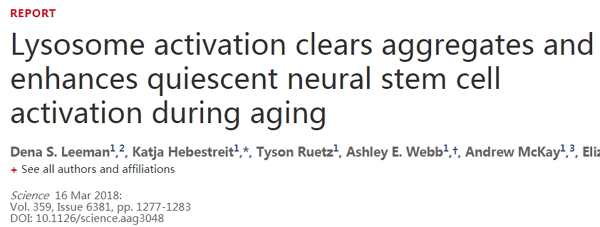Release date: 2018-03-20
In the adult brain, neural stem cells (NSCs) contain two types—stationary and active stem cells, which play different roles. To the surprise of scientists, a study published in the March 15 issue of Science revealed that young, resting neural stem cells store large amounts of protein polymers.
Moreover, these polymers are mostly present in lysosomes. As we age, the ability of cell lysosomes to treat polymers decreases, and the ability to respond to "manufacturing new neurons" signals is diminished. Anne Brunet, a professor of genetics at the Paul F. Glenn Aging Biology Center at Stanford University, led the team to confirm that restoring the normal function of lysosomes allows cells to "return" to youth.

DOI: 10.1126/science.aag3048
Unexpected discovery
The Anne Brunet team used mice as a model to find protein polymers in young neural stem cells. This surprised them, in part because similar protein accumulation is associated with neurodegenerative diseases such as Alzheimer's.
“Initially, dormant or resting neural stem cells are considered to be a very primitive cell type, waiting to be activated. However, the latest results show that their protein accumulation process is more active than activated stem cells, and this accumulation Will continue to increase with age," Anne Brunet explained. They found that removing the accumulated protein polymer can increase cell viability and promote the production of new neurons.
research process
Specifically, they isolated several types of cell populations from the brains of young, old mice, including dormant neural stem cells, active neural stem cells, and neural progenitor cells derived from active neural stem cells. The results show that resting stem cells express more genes related to lysosomes, while activated stem cells are more likely to express genes associated with the proteasome.
Subsequently, the research team added a dye that specifically binds to the protein polymer to the stationary, active stem cells. It was found that resting neural stem cells stained brighter even though the protein yield of such cells was lower. At the same time, lysosomes in resting neural stem cells process the accumulation of proteins relatively slowly relative to activated neural stem cells.
In addition, the team also confirmed that cell viability can be restored by activating lysosomes in older cells or by placing them in a "starved" state (restricting protein production).
In the face of cell aging, we still face a lot of unknowns - which kinds of proteins are more likely to aggregate? Why are activated neural stem cells more prone to proteasome than lysosome? Is protein accumulation in young cells good or bad? What are the important components that activate aging cells? This is also the mystery that Anne Brunet's team wants to solve next.
Reference materials:
Clearing clumps of protein in aging neural stem cells boosts their activity
Source: Bio-Exploration
China Extract Powder For Use As Dietary Supplement Extract Powder, Extract Powder Manufacturer
Shaanxi Kang New Pharmaceutical co., Ltd. , https://www.anabolicsteriod.com